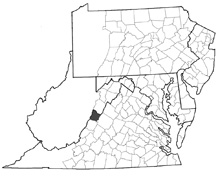> Habitat & Distribution
This small hydrobiid is apparently endemic to Bath and Highland Counties of Virginia. Hershler and his colleagues (1990) reported Fontigens morrisoni from two springs and two caves in the area, although at least one of the cave localities is obscure. One additional population in Bath County has more recently been discovered. See the paper by Gladstone and collegues (2021) for a review of Fontigens distribution generally.
The
cold, rich, hardwater springs at Mustoe seem to support high densities
of F. morrisoni,
on water cress and organic debris. But population
densities become
rapidly attenuated downstream, as though dependent on constant
temperature or some other unique aspect of the spring environment.
FWGNA incidence rank I-2, rare.
> Ecology & Life History
I am not aware of any study on the life history of Fontigens morrisoni. But populations typically seem to maintain high densities year round, as though reproduction might be continuous. The spring runs inhabited by F. morrisoni seem to be rich and stable.
Weck (2022) reported approximately one year to maturity (3 mm) in laboratory populations of the cave-dwelling Fontigens antroecetes, constant low levels of reproduction (25 - 80 eggs/pair/yr), and a lengthy hatch time of 70 - 80 days.
> Taxonomy & Systematics
This species is among the most rare and obscure of the nine Fontigens species monographed by Hershler and colleagues (1990). It is a member of the "orolibas group" characterized by a tripartite penis with a tubular distal lobe and a bulbous proximal lobe, pigmented and sighted, distinguished by its broadly-conical shell morphology. The multivariate study of Gladstone et al. (2021) confirmed that the shell morphology of F. morrisoni is distinct from most of the other recognized species studied, although not from F. aldrichi of Missouri.
The mtDNA sequence study of Liu and colleagues (2021), across 13 populations of 9 Fontigens species, included 4 individuals from the population of F. morrisoni at Mustoe. See my essay of 9Aug22 from the link below for a review.
Taylor (1966) suggested that Fontigens comprises a distinct hydrobiid subfamily, the Fontigentinae, which Hershler et al. (1990) synonymized under the Emmericiinae of Brusina (1870). Wilke et al. (2013) did not confirm a close association between Fontigens (represented by a single sample) and the European genus Emmericia, however, tentatively returning the Fontigentinae to subfamilial status. Despite this evidence, self-appointed experts insisted on placing Fontigens in the Emmericiidae for several years (Bouchet et al. 2017), until Gladstone & Whelan (2022) split the genus to its own separate family, the Fontigentidae.
> Maps and Supplementary Resources
- Fontigens distribution in Atlantic drainages (2023)
- Virginia species account with county distribution (2011)
> Essays
- Earlier versions of this website, online until August of 2016, adopted the large, broadly-inclusive concept of the Hydrobiidae (sl) following Kabat & Hershler (1993). More recently the FWGNA project has shifted to the Wilke et al. (2013) classification system, distinguishing a much smaller Hydrobiidae (ss) and elevating many hydrobioid taxa previously ranked as subfamilies to the full family level. For more details, see The Classification of the Hydrobioids.
- See my essay of 9Aug22, Startled by Fontigens, sort-of, I suppose for a review of the paper by Liu et al. (2021) documenting unusually high levels of intraspecific mtDNA sequence divergence.
> References
Bouchet, P., J. Rocroi, B.
Hausdorf, A. Kaim, Y. Kano, A. Nutzel, P. Parkhaev, M. Schrodl, and E.
Strong (2017) Revised classification, nomenclator and
typification of gastropod and monoplacophoran families. Malacologia,
61: 1 526.
Gladstone, N.S., E.
Pieper, S. Keenan, A. Paterson, M. Slay, K. Dooley, A. Engel, and M.
Niemiller (2021)
Discovery of the Blue Ridge springsnail, Fontigens orolibas
Hubricht 1957 (Gastropoda: Emmericiidae) in East Tennessee and its
conservation implications. Freshwater Mollusk Biology and
Conservation 24: 34 - 42.
Gladstone, N. S. and N.
Whelan (2022) Pushing barcodes to their limits:
phylogenetic placeament of Fontigens
Pilsbry, 1933 (Caenogasatropoda: Littorinimorpha: Truncatelloidea) and
elevation of Fontigentidae Taylor, 1966. Journal of Molluscan
Studies 88: eyab038.
Hershler, R., J.R.
Holsinger & L. Hubricht (1990) A revision of the
North American freshwater snail genus Fontigens
(Prosobranchia: Hydrobiidae). Smithsonian Contributions to Zoology
509:1-49.
Kabat, A.R., and R.
Hershler (1993)
The prosobranch snail family Hydrobiidae (Gastropoda: Rissooidea):
review of classification and supraspecific taxa. Smithsonian
Contributions to Zoology 547:1-94.
Liu, H-P., L. Schroeder, A.
Berry, and R. T. Dillon, Jr. (2021) High levels
of mitochondrial DNA sequence divergence among isolated populations of Fontigens
(Truncatelloidea: Emmericiidae) in eastern USA. Journal of
Molluscan Studies 87: eyab026. [pdf]
Stewart, T. W., &
R. T. Dillon, Jr. (2004)
Species composition and geographic distribution of Virginia's
freshwater gastropod fauna: A review using historical
records.
Am. Malac. Bull. 19: 79-91.
Taylor, D.W. (1966) Summary
of North American Blancan nonmarine molluscs. Malacologia
4: 1 - 172.
Weck, R.G. (2022)
Life history observations of the Illinois state
endangered Enigmatic Cavesnail, Fontigens
antroecetes (Hubricht, 1940) made under simulated cave
conditions. Subterranean Biology 43: 185 - 198.
Wilke T., Haase M.,
Hershler R., Liu H-P., Misof
B., Ponder W. (2013)
Pushing short DNA
fragments to the limit: Phylogenetic relationships of hydrobioid
gastropods
(Caenogastropoda: Rissooidea). Molecular
Phylogenetics and Evolution 66: 715 736.








